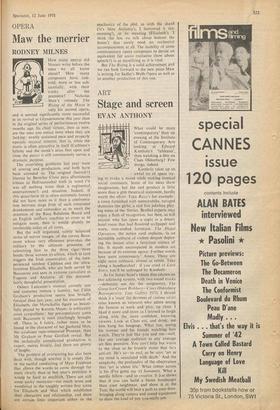ART
Stage and screen
EVAN ANTHONY
What could be more `contemporary' than an evening at the Institute of Contemporary Arts looking at Edward Kienholz's 'tableaux', then watching a film on Claes Oldenburg? Few things, indeed.
Kienholz takes up an awful lot of space try- ing to evoke a mood while making ironical social comments. Some of his ideas show imagination, but the end product is little more than a glib theatrical statement, hardly worth the effort. Take Roxy's for example : a room furnished with memorabilia, ravaged dummies (les girls), a real live jukebox play- ing tunes of the 'forties. Brothel experts may enjoy a flash of recognition, but then, so will anyone who has spent a night in a dreary hotel room that had flowered wallpaper and worn, over-stuffed furniture. The Illegal Operation, the notice card explains, 'is an incredible outburst of violent despair depict- ing the instant after a ferocious seizure of life. It stands uncompared in modern art because of its extreme agony. Further words here seem unnecessary.' Amen. There are eight more tableaux, almost as subtle. Take along a handkerchief : if you cried at Love Story, you'll be unhinged by Kienholz.
As for James Scott's 16mm film (shown on two adjoining screens, with two sound tracks —definitely not for the astigmatic), The Great Ice-Cream Robbery--Claes Oldenburg Retrospective. Tate Gallery 1970, I should think it a 'must' for devotees of cinema verite (also known as voyeurs) who adore seeing the famous at work and play, up close. I liked it more and more as I learned to laugh along with the more confident, knowing viewers. Look at Claes eat, and drink; see him hang his hangings. What fun, seeing his woman and his friends watching him watch. They're just like you and me—well. like any average audience at any average art film premiere. You can't help but warm to the chap as he frankly states that lie's anti-art. He's so—so real, as he says, 'art in my mind is associated with death.' And the simplicity, the profundity of the observation that 'art is about life.' What comes across is his (I've gotta say it) humanity. What a terrific fellow—and so creative. It just shows that if you can build a better hamburger than your neighbour, and show it at the Tate, the world will beat a path to your door, bringing along camera and sound equipment to show the kind of guy you really are.


































 Previous page
Previous page